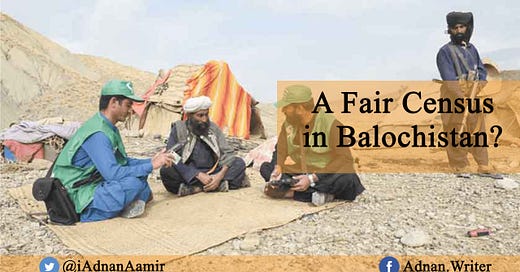The seventh population census is underway in Pakistan. The conduct and results of the census are important because in Pakistan the population figures determine, among other factors, the distribution of the National Assembly seats, job quotas, and resource distribution under the National Finance Commission (NFC) among the provinces. Therefore, transparent conduct of the census is critical for smaller provinces like Balochistan.
Following the census of 2017, the main issue relating to the census in Balochistan was the inclusion of Afghan refugees. Several political parties in Balochistan demanded that Afghan refugees not be included in the count. After this demand was accommodated to some extent, there were not many protests and objections.
The current census has concluded in Balochistan except in Quetta, where it will conclude on May 15. This time the census is being conducted digitally with the help of Android-based tablets. This method has made census data tabulation and compilation more efficient and easier. However, the questions regarding the capacity of the government to carry out the data collection process with overburdened school teachers, who are going door to door to enumerate people, remain.
According to the population data of all districts of Balochistan – as of May 5 – acquired by this scribe, the population of Balochistan stands at 20.35 million. Balochistan has witnessed a 65 percent increase in population compared to the 2017 census. The share of Balochistan in the national population has increased from 6 to 9 percent.
This increase in population will likely result in an increase in Balochistan’s representation in the National Assembly from 16 to 23. The job quota for Balochistan will increase from 6 to 9 percent and there will be an increase of tens of billions of rupees in the annual share of Balochistan under the NFC. All of these can be seen as welcome developments, especially in the context of past deprivation.
The most interesting aspect of the census is the massive population increase in several districts of Balochistan. Seven districts of the provinces have witnessed a population increase of more than 100 percent. Washuk district leads with a 268 percent increase; followed by Panjgur at 231 percent; Kharan at 224 percent; Kacchi and Sherani both at 157 percent; and Harnai at 152 percent.
Based on interviews with government officials and people involved in the enumeration process, there are multiple reasons for this increase. First, in the 2017 census, the population was undercounted due to the security situation as it was not possible to reach every nook and corner of the province. Many people had moved away from their home districts and remained uncounted. Hence, the recorded population in 2017 was less than the actual. That’s why the increase this time appears remarkably large.
“Without proper monitoring and active participation from political representatives, any census process will be flawed,” says Saadullah Dehwar, provincial social media secretary of the National Party.
Shahzada Zulfiqar, a political analyst based in Quetta, agrees with this assessment. “There is no doubt that people could not be counted accurately in 2017 due to security issues and the manual nature of the census,” he tells The News on Sunday. He adds that even during the ongoing census many people in peripheral areas were not counted for lack of identity documents such as a CNIC or B-form.
Some critics of the ongoing census say that the massive increase in population in many districts of Balochistan is due to exaggeration by the district government officials in connivance with the local population. Although there have been a few instances of attempted falsification of records, there is no concrete evidence to link the increase in population to such efforts.
Zulfiqar says that there is no evidence to back up the claim of the mass exaggeration of population figures in Balochistan. “These claims are akin to political workers leveling allegations of rigging after every election once their party loses,” he says while dismissing these concerns.
Also, while several districts of Balochistan have witnessed big population increases, the population in Quetta has increased by only 1 percent. This sounds very strange. This is why the census operations in Quetta have been extended till May 15 to cover the missing population.
Saadullah Dehwar, the provincial social media secretary of the National Party, is actively involved in the census monitoring process in Quetta on behalf of his party. “The Afghan refugees who were living in Quetta during the 2017 census returned to Afghanistan after the Taliban takeover. This has also contributed to a population decrease in the capital,” he tells TNS. He says that school teachers tasked with enumeration duties in Quetta were overburdened and hence, it was difficult for them to cover the entire Quetta city in time.
Dehwar adds that Members of the Provincial Assembly (MPAs) from Quetta took the least amount of interest in the census process. “Without proper monitoring and active participation from political representatives, any census process will be flawed.”
The census results so far are encouraging for the people of Balochistan. However, there are fears that once the exercise concludes countrywide on May 15, the apparent gains of Balochistan (in reference to the population count) may be offset by a similar increase in the population of other provinces. If these concerns turn out to be true then not only will they aggravate the sense of deprivation in Balochistan but will also exacerbate the political and security situation in the restive province.
Note: This article was originally published here.





